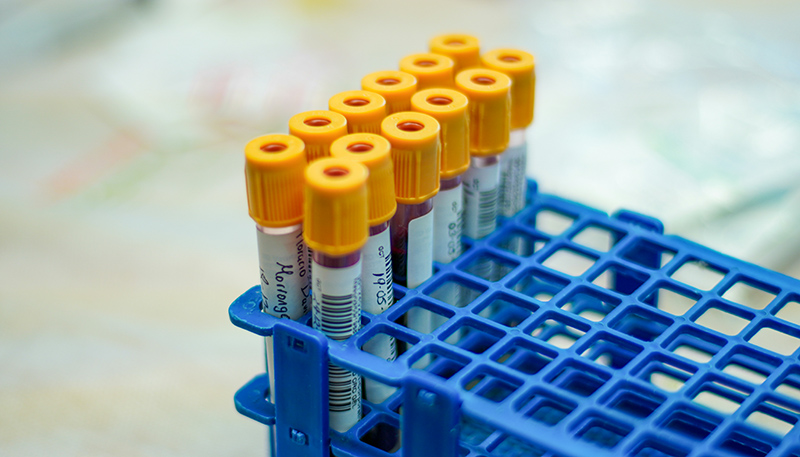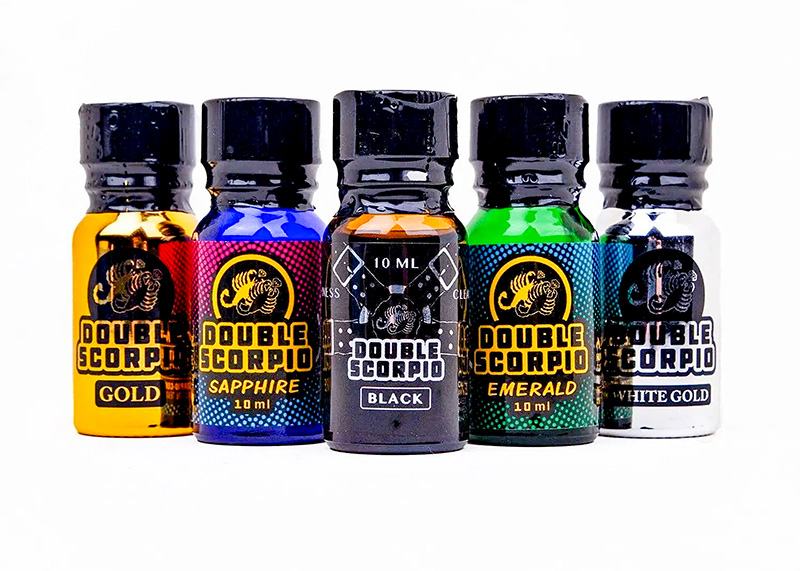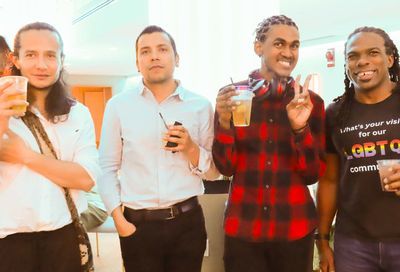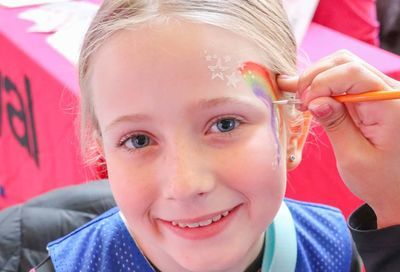Chef Rasheed Abdurrahman Serves More Than 1.9 Million Meals a Year
Food & Friends Executive Chef Abdurrahman runs one of the DMV area's most demanding -- and life-nourishing -- kitchens.

Put a little boy on a farm in rural Virginia, have him hunt for his supper in lean times, wistfully recall holiday feasts at Grandma’s house, and a dear uncle who’s passed, and you’ve got all the ingredients for a No. 1 country song.
Follow the line from the farm to urban retail, to the Culinary Institute of America, to owning a café in Hyattsville, to a boutique caterer, to running the kitchen at Food & Friends, and Executive Chef Rasheed Abdurrahman’s story is more than a song. It’s a feast.
And it’s a feast with an impressive number of spinning plates. With plans for Thanksgiving already underway at D.C.’s most ambitious provider of nutritionally sound meals for those facing life-challenging illness across an area of nearly 5,500 square miles, Abdurrahman must also maintain a focus on the present.

Not only are there thousands of daily deliveries of meals and groceries to manage, but there is the pressing matter of Chef’s Best. The annual event, Food & Friends flagship fundraiser, was sidelined over the past few years by the Covid pandemic.
Come Aug. 21, this tasty treat returns, showcasing star chefs from the DMV. Chef Rasheed is no slouch, and he’ll be right there with them, offering attendees a sophisticated sample from what is arguably the area’s most caring kitchen.
Despite the spinning plates, Chef Rasheed managed to carve out a little bit to time for Metro Weekly to help us whet our appetites for Chef’s Best.
METRO WEEKLY: What is your history with Food & Friends? You started there six years ago or so?
RASHEED ABDURRAHMAN: Five years. On December 3, it will be five years. I was brought in to be the executive chef here. But my history with Food & Friends goes back even before I started working here. It was one of my go-to places where I would donate funds. I never volunteered here, because I really didn’t have time, but I always gave money to Food and Friends.
MW: Why was Food & Friends on your radar?
ABDURRAHMAN: We have a really good outreach program here! I would often get things in the mail. And I would hear through friends about the good work that Food & Friends was doing in the community. I have family members who have had numerous medical issues — including HIV — over the years. The Food & Friends mission really touched me.
Being a chef, we are very conscious of food deficiencies in the community. Every chef I know has always done the best they can to try to help people out, to donate food, make extra food, or just be available to help people in the community.
Food & Friends touched on two of the things that were very close to my heart, so that’s why I donated money.
MW: The two things close to your heart?
ABDURRAHMAN: Helping people in the community, and also making sure that everyone has a right to food. As wealthy as this country is, no one should ever be hungry in this country. It blows my mind when I see how much food is just wasted throughout the world.
MW: What you were doing before you came on as executive chef?
ABDURRAHMAN: I worked as an executive chef for a small boutique catering company that specialized in weddings. We were in the process of about to shut down our operations, so I started looking for a new job. I saw that Food & Friends was listed an online employment site, and I said, “Oh yeah, that’s interesting. That aligns with my values and what I’d like to bring to the community.”
I’ve been a chef for over 34 years now, and — I hate to use the word talent — but the skillset that I have learned over the years working in the kitchen, I thought I might be able to bring to Food & Friends, just purchasing the things that are really necessary to run a nonprofit organization to make sure that it stays….

MW: So it doesn’t go bankrupt.
ABDURRAHMAN: Yes, so they can keep more people, feed more people for a long period of time. One of my goals when I thought about coming to Food & Friends was I didn’t want to break anything. I wanted to make it better. When I finally leave, I want it to be better than when I found it.
MW: I don’t know how much you enjoyed your previous job, but I’m wondering if this was all a serendipitous twist of fate that puts you into a position that is ideal for you.
ABDURRAHMAN: I loved my last job. I loved the people that I worked for. We had a great team. I was sad when the business started to close, but I’m a mature adult. I’ve had many jobs throughout my life and I know things run in cycles.
It was very serendipitous that I got this job, because I never sought out to be a chef. I worked in retail. I used to be a manager of Georgetown Leather Design way back in the day. When I decided to leave there after 11 years, I said, well, what do I want to do? I knew I didn’t want to own a leather store.
My wife said to me, “You love to eat and you love to cook. Why don’t you go to culinary school?” I was well into my thirties by that point, and I said, “No, I’m too old to go back to school and learn a new trade and blah, blah, blah.” And she said, “Well, just look into it.”
Of course, she’s smarter than I am. I looked into it and I ended up going to the Culinary Institute of America.
Like I said, I’ve always loved food. I’ve had different parts of my life where I’ve grown different stages. One part of my life, I was a little food deficient myself. Another part of my life, I lived on a farm and we grew food. I had an intimate relationship with the food, the work that goes into it, how much love and attention you need to put in. Just standing out in the hot sun in July and pulling weeds, that makes you put a different value on food and the relationship to it.
MW: All this touches on things that Food & Friends does. I mean, one, you said that HIV affected someone in your family.
ABDURRAHMAN: Yes. I had an uncle who passed away from HIV.
MW: I’m sorry about that. Was he local?
ABDURRAHMAN: Yes. Yes, he was. I’m a native Washingtonian, third generation. My Uncle David used to be an organist for churches, local churches. A very caring, giving person.
MW: He wasn’t a client of Food & Friends by chance?
ABDURRAHMAN: No. I think he passed, it would’ve been 1989. So Food & Friends had just started. He probably had not heard about it. And he was very secretive about his illness. We didn’t know.
MW: Yeah, a church organist in 1989. That’s —
ABDURRAHMAN: A different time. Different time.

MW: You also talked about in your own life having been food deficient. When you go through that, you don’t forget.
ABDURRAHMAN: Oh, for sure. Yeah. I know what it’s like to be hungry. I mean, at some point in Virginia, I didn’t have any food. My stepbrother and I used to go hunting in the woods just so we could catch something to eat.
MW: Wow, what did you catch?
ABDURRAHMAN: Whatever moved. We caught rabbits, we caught squirrels, we shot quail. Let’s see…. Not so much frogs. We would catch fish in the summer. But mostly birds. Wild birds and squirrels and rabbits, small deer.
MW: Which woods were these?
ABDURRAHMAN: We lived on a 33-acre plot of land in Fauquier County, Virginia. There’s a small town called Bealeton, which is probably all subdivisions now.
MW: You’re a hunter and a chef. If somebody handed you a squirrel, in an hour I could come back and have squirrel stew?
ABDURRAHMAN: Oh, for sure. Or just roast it. Obviously, there’s not much meat on a squirrel, but when you’re hungry a little bit goes a long way.

MW: You know how to dress it, you know how to skin it?
ABDURRAHMAN: Oh, yeah. I’ve dressed sheep and goats before. I don’t do so much of that anymore. I did it out of necessity back then. And I do have a love of animals, so it was hard for me to do that. But I also needed to eat, so….
MW: What is a typical day for you at Food & Friends? Like, yesterday, what time did you arrive? What did you do? When did you leave? How much got done?
ABDURRAHMAN: A typical day for me is I come in between 6 and 6:30. I may leave around 5 or 5:30.
MW: A long day.
ABDURRAHMAN: Yeah, it’s a long day. But a nice thing about Food & Friends is they’re very conscious about taking care of our clients and our volunteers, but they take care of the staff also. We’re only responsible for 37 hours of work, and we get paid for the other three. As a manager overseeing the kitchen, I tend to work a lot more hours, because it’s necessary.
I work in conjunction with the dieticians. We work together, collectively, and we problem-solve. I love that about Food & Friends. I love the upper management here because they listen. If I have requests, they listen to me. I won’t say they give me everything that I need because, obviously, being a nonprofit, there’s budget constraints. But they listen to our requests, they take them seriously. If they can’t fulfill those requests, then we discuss solutions, what are next steps? They’re very proactive.
I know we’re in a weird place with Food & Friends, because we’re a smaller nonprofit, but we do big work. A lot of places that do big work aren’t able to pivot. Like when Covid first happened, we stopped what we were doing. We made sure all of our clients had food for two weeks. Then we sat down, we thought collectively, really thought about how we should approach the next year, and we came up with a solution. We changed how we operated.
Normally, we were sending food three days a week to clients, a combination of fresh and frozen. With Covid, we regrouped and started sending all frozen foods one day a week. It was a benefit to the client, because now they only have to stay home [for delivery] one day of the week, versus three days. It was a benefit to us because we could prepare food for five days in advance and keep it in the freezer, plan out operations for distribution. It didn’t require us to have as many delivery drivers, and we saved money on gas. All that money we saved we were able to put back into the food. Hence, we were able to serve more people this year than we’ve ever served. We’re at 1.9 million meals.
MW: Talking about the pivoting, having to adapt quickly I’m reminded of one of my favorite Food & Friends stories, a bit before your time, when Hurricane Katrina happened. We had school buses bringing up evacuees. I don’t remember how many hundreds of people, it was maybe 350 people if memory serves. The Food & Friends kitchen came up with meals for all of these people. If that request comes to your kitchen, are you ready?
ABDURRAHMAN: Oh, for sure. I’ve heard that story before, and it’s a great story. The people who tell it, you can hear the passion in their voice when they share that story and how proud they were of being able to do that.
I have a really good team here. We have excellent volunteers. So when the client numbers started to go up after Covid, when my supervisor, Leslie Woolley said to me, “We need X amount of meals, we’re going to be increasing, increasing, increasing,” I never said no. I just said, “How many? How many?” That’s not a problem. Obviously, there are some limitations because of our building size and our storage.
Right now, we’re pretty much at capacity with the building. If we rented another freezer or two to put outside, then yes, I could make some more meals. I could do probably do another 100,000 meals and store them somewhere, as long as they’re continually coming and going.
This year, like I said, we are pretty much going to finish out at 1.9 million, and we’re budgeted for 2 million next year. We are picking back up and starting right where we left off. We can handle it.
Food & Friends is a place where there are a lot of smart people. It’s unlike a lot of places where people throw their hands up and go, “No, we can’t do it.” We figure a way to make things happen.

MW: It’s a diverse bunch of minds over there, I think.
ABDURRAHMAN: It really is, isn’t it?
MW: Going back to your mention of food deprivation as a child, there must have also been good times.
ABDURRAHMAN: Yeah, for sure.
MW: What memories from childhood do you have of when there was plenty?
ABDURRAHMAN: There were only a few times when I was food deficient. My mom was an excellent cook. She learned how to cook from her grandmother. And my mom, not only was she a great cook, but she also was very creative. Back in the sixties and seventies, in the African-American community, when everybody’s eating canned foods and frozen foods, my mom was making curried goat or barbecued goat or octopus. We were eating octopus. A very unusual combination of foods, but always delicious, always made with love.
Thanksgiving was one of those really great meals. The traditional turkey, all the mac and cheese, all that kind of comfort food is really delicious.
MW: How many people would be around for Thanksgiving when you were a kid?
ABDURRAHMAN: Depends on whose house. If it were my grandmother’s house, it would be maybe 25. Our house, maybe 12, 14.
MW: That’s still quite a few. Thanksgiving at Food & Friends is also kind of a legendary time. How does that clock work? I mean, I remember former Executive Director Craig Shniderman talking about how his mother would come into the kitchen, be there at six o’clock in the morning or something. How does it run under you?
ABDURRAHMAN: I’m a stickler for organization and planning. That’s the only reason why I’m here. That’s the only reason I keep my job, because there are a lot of moving parts in a kitchen this size.
I start thinking about Thanksgiving in July. I start calling out to vendors, finding out turkey prices, availability, making sure that we can meet the needs of the clients. Once I lock down my turkeys, the next step is I lock down the rest of the food. By September, I have an idea of all the food that I need to order because we generally serve, in addition to our current client numbers, we do about another 820 Thanksgiving meals every year.
Keep in mind, I just have five people on staff. I don’t have 20, 30 chefs. It can be a daunting task, but we plan ahead, we order ahead, we make sure everything’s in place. That way if something unexpected happens, we’re able to pivot and continue moving forward. We rent extra freezers outside. It’s all planned out. On the Friday before Thanksgiving, that’s when the turkeys come in. We inspect every single turkey by hand. We put them in one of the rented freezers. On that Sunday, we start pulling turkeys. We usually cook about 230 a day, Sunday, Monday, Tuesday, and Wednesday. By Wednesday, we’re finished cooking all the turkeys. They all have to be cooled down and then wrapped in foil for transportation.
We have different volunteer shifts, where each volunteer is doing a specific job. Some people are portioning out cranberry sauce, some people are portioning out gravy, some people are doing the various sides of vegetables, adding butter. We have a whole schedule working. It starts now.
MW: Do you have kids? Did you teach them about nutrition?
ABDURRAHMAN: I have two children who are now two adults. They both grew up in a relatively healthy household. We would always have greens — kale or collards or salads. There was always a vegetable with every meal. There was always lots of fruit available.
We all need to have some reminders of what a healthy meal looks like, eating the rainbow. Surprisingly though, at least in the Washington, D.C. area, I have experienced a lot of classrooms where students are being taught about what healthy food looks like. A lot of schools, especially in D.C., have community gardens that the kids work in.
I think it’s more governmental, because the standards that are in the school system are dictated by the government. Everything starts with the federal government and what they determine is a healthy meal. You probably remember something during the Reagan Administration: ketchup.
MW: Ketchup is a vegetable.
ABDURRAHMAN: Exactly. As we know, that’s not a meal, that’s not a vegetable. It’s a condiment.

MW: And we’re still the richest country in the world.
ABDURRAHMAN: And we’re still the richest country in the world, that’s right. The teachers are really doing a great job, and they present what it looks like to have a great meal. I know the school system does a really good job providing meals to kids who may not have enough meals in the home. But, again, what the federal government says is an acceptable meal, that’s where it all starts. The federal government has been getting much better lately, I will say that.
MW: Do you have a signature dish?
ABDURRAHMAN: I used to have a cafe in Hyattsville, Md., and I was featured in The Washington Post for my mac and cheese. I guess that’s my signature dish, because people liked it so much. I tend to eat more in the Mediterranean diet, so I love roasted meats and lots of veggies and things like that.
MW: What was your cafe in Hyattsville?
ABDURRAHMAN: It was called Wild Onion. We were there for about four years. I opened in 2008, two months before the Great Recession. I was able to keep it going for four years, but it was just too much debt.
MW: Would you ever go back to it? I mean, if somebody came down and said, “Here’s a bag of money, open a restaurant.”
ABDURRAHMAN: Only if I could do that while I keep this job. I’m not in a hurry to get back into restaurants. And I really do love what I do here. But you never know where the future takes you. If I were to do something, it would be more into food manufacturing, creating a line of sauces, things like that. It’s less taxing. A cafe, a business like that, is seven days a week. I worked 16-hour days, seven days a week.
MW: Sauces? Do you have a signature sauce?
ABDURRAHMAN: Yes. For the last four or five years, I’ve worked with the Chesapeake Bay Foundation with their “Burgers & Brews” [now Food & Farm Fest] events. At their farm in Upper Marlboro, they would take some of the animals from the farm and they would process them, and then they would serve them as burgers. I would always do this Mediterranean lamb burger. The sauce that I would do was a roasted-tomato harissa sauce that would go on the lamb burger. That would be my signature sauce.
MW: So, Chef Rasheed Tomato Harissa Sauce?
ABDURRAHMAN: I’ve started making chili-garlic sauce too. Chili-garlic crunch lately. I put mushroom powder in it. A lot of people started doing that, but it’s just delicious. I put a little extra-crispy onions in there.
MW: You’ve done Chef’s Best before, even though this is a comeback, but you were there before the pandemic. Can you tell us what you’ll be preparing?
ABDURRAHMAN: A little hours d’oeuvres. The base is brioche. It’s going to be a crab dip. If you can think about, I’ve done a combination of a new and old. It’s a brioche toast with a crab. An old-fashioned, creamy, cream cheese and sour cream, Crab Imperial kind of dip. With some pureed Chinese five-spice sweet potatoes on top, and then some scallions and some chili garlic oil.
MW: That sounds amazing.
ABDURRAHMAN: I’m hoping all the flavors come together. Chef’s Best is really cool, because we’ve got really talented chefs donating their time. These are really top-notch chefs. They’re some of the best in the community. I just want to bring my “A game.”
MW: That sounds like an uber-fancy kind of treat. That’s no slouch.
ABDURRAHMAN: We also have a vegetarian version, which is the same dish, but with hearts of palm. It’s a mock crab.
MW: Anything you’d like to add before we let you get back to the kitchen?
ABDURRAHMAN: I just want to say thanks to everybody in the community who supports Food & Friends. There’s a lot of organizations in D.C. and there’s a lot of places that people could donate their time and money. Fortunately, a lot of folks choose to come here because it’s a community here. We honor the volunteers, we honor the clients, and we honor each other. We’ve had many clients who volunteered here, who then found out they were sick and became clients. It happens. Food & Friends has a tagline that says, “Anyone can get sick, and everyone can help.” This is true. This is what we do.
Chef’s Best Dinner & Auction is Monday, Aug. 21, at the Marriott Marquis Washington, D.C., 901 Massachusetts Ave. NW. The President’s Reception is from 5:30 p.m. to 6:30 p.m. Gourmet Chef Tastings Reception & Casino games, 6:30 p.m. to 8:00 p.m.
Dessert, Program and Live Auction at 8:15 p.m. Attire is business/cocktail. Tickets are $350. Visit www.foodandfriends.org/engage/chefs-best.
Disclosure: Metro Weekly contributor Will O’Bryan’s husband serves as a volunteer board member at Food & Friends.
Support Metro Weekly’s Journalism
These are challenging times for news organizations. And yet it’s crucial we stay active and provide vital resources and information to both our local readers and the world. So won’t you please take a moment and consider supporting Metro Weekly with a membership? For as little as $5 a month, you can help ensure Metro Weekly magazine and MetroWeekly.com remain free, viable resources as we provide the best, most diverse, culturally-resonant LGBTQ coverage in both the D.C. region and around the world. Memberships come with exclusive perks and discounts, your own personal digital delivery of each week’s magazine (and an archive), access to our Member's Lounge when it launches this fall, and exclusive members-only items like Metro Weekly Membership Mugs and Tote Bags! Check out all our membership levels here and please join us today!


























You must be logged in to post a comment.